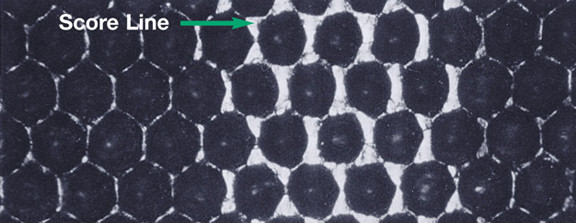Scoring or "shiny-lines" are a sometimes-controversial subject on what causes them. What is not controversial is that they can ruin expensive anilox rolls and cause waste in print jobs. As in most problematic situations, it is never one thing that causes or can eliminate the problem. When diagnosing the problem, it is also important to understand the difference between what is considered "scoring" vs. "fill-in".
"Fill-in" is a characteristic of an anilox roll that is often misdiagnosed as score lines. The physical appearance of fill-in on the actual anilox roll is very much like that of score lines; however the ink releasing characteristics are 180° apart from one another. Score lines typically result in an excess of ink film thickness being delivered to the substrate due to the wearing down of the land area between individual cells. These damaged cell walls then allow the affected scored area to flood with ink resulting in an increase in ink film thickness and appearing as heavier or denser lines. Fill-in results when foreign materials lodge between the anilox roll and doctor blade, and as a result of friction and heat the foreign material "fills in" the individual cells around the anilox roll. The affect of fill-in on the printed substrate is a lack of ink transferred in the affected area. Because the individual cells of the anilox roll are filled with a form of debris and the land area of the roll is still being wiped clean by the doctor blade, very little ink volume can be transferred to the substrate. Although many foreign materials lodged between the anilox and metering blade can lead to fill-in, dried ink and metal are the two most common. If you are still unsure if the problem you are having is fill-in or scoring, please contact your anilox manufacturer or APR for help in fully diagnosing the problem.
As score lines are the more costly problem, we will focus the remainder of this tech tip on the limitation of them. Usually a number of preventive measures must be diligently adopted to reduce the risk of score lines becoming a major source of unwanted costs.
Some of these include:
Doctor Blade Pressure - once a blade is in contact with the surface, any additional pressure simply bends the blade, increasing wear and creating heat from increased friction. Unwanted increased pressure can inadvertently occur when shorter worn blades are replaced with the new, longer doctor blade, and needed readjustments are not made. When over-pressured, the doctor blade bends back causing wear on the side rather on the tip. As the side of the blade wears through, the tip breaks away in the form of a long metal "sliver" which can become lodged between the blade edge and anilox cell walls. Other causes of uneven blade pressure can include chamber alignment problems, attempts to stop chamber leaking issues, operator error or lack of knowledge, rippled or improperly loaded blades, and using blades too long for chamber design.
In an effort to reduce these potential blade issues:
- Train all press personnel of the dangers of over impression on doctor blades.
- Keep chambers and blades properly aligned. Regularly check to make sure that upper and lower blades come into contact with the anilox at the same time.
- Tighten blade holder clamps from the center out using even pressure, and make sure brackets are clean so blades are not rippled.
- When new blades are installed, reset chamber pressure. Review your "standard operating procedure" for when doctor blades should be changed, how, and proper press re-start-up.
- Never allow blades to come into contact with a rotating dry anilox roll.
- Do not try to use pressure to stop chamber-leaking issues.
- Plastic or composite blade should also be considered to minimize the opportunity for steel material to be introduced to the ink distribution system.
- Magnets - magnets in either the ink container or within the filtration system can capture metal fragments in the inking system. The placement of these magnets is also important to ensure capturing the particles before they can be sent back to the roll.
- Filters - filters can remove fragments of doctor blades made of any material, agglomerated ink particles, and any other foreign material that may find its way into the ink system. The size of particles removed is limited only by the mesh of the filter itself (different meshes available based on your needs). Regular maintenance of the ink system filters is required to remove accumulated particles and ensure full system flow.
- Other preventive measures can include:
- Keep the press as clean as possible to minimize dried ink particles accumulating and "dropping" into the press.
- Check chambers, doctor blades, and all other metal for corrosion.
- Use high quality blade materials and anilox rolls. Select the right blade for the application. Today there are numerous blade typesÉsteel, coated steel, composites, plastic, etc. Each has its own metering characteristics and optimal utilization criteria. Choosing the right blade and using it correctly can assure higher quality print, lower annual blade cost, and less shut down time due to blade or anilox problems.
All Printing Resources offers services both to check presses for possible scoring conditions and assist in training employees on how to prevent scoring of expensive anilox rolls as well as many products designed to resist scoring conditions. We also carry the most complete line of blade types to assure choosing the right blade for each application and production requirement.

